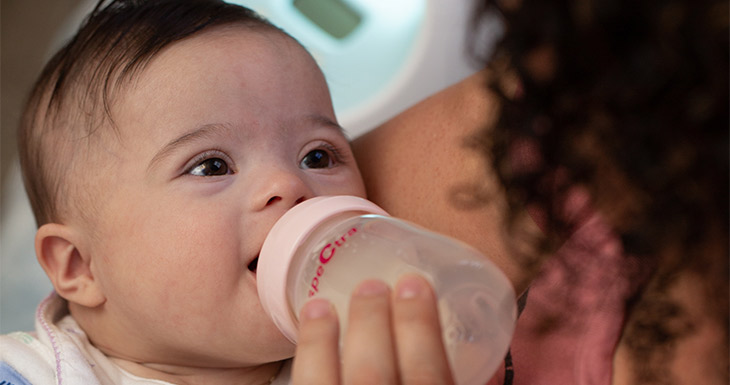Breastfeeding A Baby With Special Needs
Melissa Portunato MPH, IBCLC, RLC
All babies benefit from the nutritive properties of breast milk but the benefits are even more significant for babies with special needs. For instance, premature babies or babies with congenital disorders like Down Syndrome, are at a higher risk for upper respiratory infections and health problems early in life. Many studies show these babies do better when they receive mama’s milk. As a matter of fact, breast milk is so important for babies with special needs that it is quite likely they will receive donor breast milk at birth if mom cannot provide her own breast milk. Breastmilk can never be duplicated and can enhance the health, growth and development of fragile babies.
Here are 5 Tips For Breastfeeding A Baby With Special Needs:
If Baby Can Latch
There are some cases where the baby will not medically be able to nurse directly but often a baby will be encouraged to suckle at their mother’s breast. Positioning can be critical for a baby with a congenital disorder like Pierre Robin’s Syndrome or Down Syndrome. If baby is able to practice at the breast, try a nursing position like the “dancer hand” that supports the chin and jaw. Babies with congenital disorders can often have low muscle tone making it difficult to nutritively suckle at the breast. Providing chin and jaw support by using the “dancer hand” position can help keep baby feeding at the breast for longer and more effectively during nursing sessions. Allowing the baby to come to the mother’s breast can help milk production, increase bonding and promote the overall well being for both mommy and baby. It’s not only about nutrition but about the bond as well.
Try an Alternate Feeding Method or Tool
A supplemental nursing system can be used to supplement the baby while suckling at the breast. A soft medicine cup or spoon can also be used to feed a baby allowing the baby to continue to practice at the breast. A nipple shield can be used as a temporary tool to encourage more nursing directly at the breast. If bottles need to be used, try the Paced Bottle Feeding Techniquewhich can allow the baby to control the flow of the bottle. Paced bottle feeding prevents overfeeding which can lead to the discomfort associated with colic, gas and reflux.
Maintaining Milk Supply
It’s recommended to pump a minimum of 8-12 times per day with a hospital strength breast pump to ensure healthy milk production. Learn more about finding the perfect Spectra Baby USA hospital strength breast pump here. If you are separated from baby watching videos or seeing pictures of your baby while pumping can stimulate more effective letdowns.
Finding the right size flange is an important part of the pumping process. A flange that doesn’t fit properly could leave you with nipple pain, redness, and full breasts. Pumping shouldn’t hurt! If you are experiencing any of these symptoms measure your nipples using our breastshield guide for the correct flange sizing. Spectra baby USA offers free sizing via virtual consults and email IBCLC@spectrababyusa.com. We’re here to help!
Skin to Skin
Skin to skin is an important way to sustain your breastfeeding hormones and continue bonding with your baby. Mama’s chest is a newborn baby’s natural environment. It promotes healing and encourages transitioning back to the breast if that’s your goal. Skin to skin should be done on your bare chest and with baby only in a diaper. Try to do skin to skin any chance you can get. You can even do it while pumping for quicker and easier letdowns! Combining skin to skin with pumping can increase milk volume, increase weight gain, stabilize the baby’s heartbeat, and is even linked to premature babies going home sooner! If your special needs baby can’t be brought skin to skin, pumping crib side can keep your milk flowing while staying close to your little one.
Set realistic expectations with the right support
Breastfeeding a baby with special needs directly at the breast may come with challenges but you can still provide breast milk for your baby even if baby is not latching directly to the breast. Breastmilk can help babies recover sooner from surgery and lower the risk of infection. Working closely with a medical team including a lactation specialist like an IBCLC (International Board Certified Lactation Consultant), Pediatrician, and Neonatologist will help in providing the support and education parents need to be successful. Finding a local support group can help special needs parents connect with their community and find emotional support when they need it most.
Are you pumping for a baby with special needs? Share your story with us! We’d love to hear more about your journey! Email us at IBCLC@spectrababyusa.com.
Sources
Seddon PC, Khan Y. Respiratory problems in children with neurological impairment. Arch Dis Child. 2003;88(1):75-78.
Proesmans M. Respiratory illness in children with disability: a serious problem?. Breathe. 2016;12(4):e97.
Zeisel SA, Roberts JE. Otitis media in young children with disabilities. Infants Young Child. 2003;16(2):106-119.
Baby-Friendly Hospital Initiative: Revised, Updated and Expanded for Integrated Care. Geneva: World Health Organization; 2009. Session 10, INFANTS WITH SPECIAL NEEDS. Available from: INFANTS WITH SPECIAL NEEDS – Baby-Friendly Hospital Initiative




